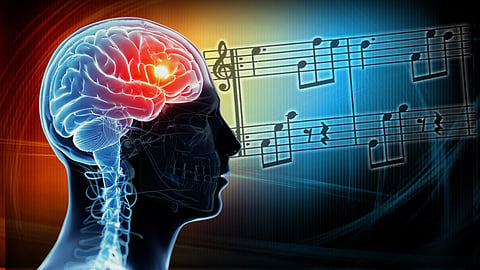
- Home
- Live Blog
- Breaking News
- Top Headlines
- Cities
- NE News
- Sentinel Media
- Sports
- Education
- Jobs

Dr. Rijusmita Sarma
(The writer is a counselling psychologist.
She can be reached at 8638716076)
Music has always been viewed as a source of entertainment and a socio-cultural phenomenon. But science says music has much more to offer. Neuromusicology, an interdisciplinary area comprising the principles of psychology, neuroscience, and musicology, has helped us understand the effect of music on the brain. This specialized field studies how different areas of the brain are activated and interact when a person listens to, performs, or creates music. This is done by analysing and studying brain activity using advanced neuroimaging techniques. For e.g., functional magnetic resonance imaging (fMRI) has helped scientists witness real-time activities of the brain in response to music. Neuromusicology aims to study how the brain receives and maps sound waves from musical stimuli, how the brain encodes, stores, and retrieves musical information, the emotional reactions evoked by music, the neural mechanisms behind the physical act of playing a musical instrument, singing, or tapping to keep rhythm, etc., and investigate how musical training and experience can shape and reorganize the structure and function of the brain. It also studies the involvement of different parts of the brain in executing these functions. Music also influences the chemistry of the brain by releasing neurotransmitters like dopamine and serotonin.
Since 2006, neuroscientist Kiminobu Sugaya and violinist Ayako Yonetani have been teaching a course at the University of Central Florida. It aims to explore the impact of music on brain function and human behaviour. They have found music to be beneficial in reducing stress, pain, and symptoms of depression. Music has also been reported to help improve cognitive and motor skills, temporal-spatial learning, and neurogenesis (the brain’s ability to produce new neurons). They have revealed that people suffering from neurodegenerative diseases like Alzheimer’s and Parkinsonism also respond positively to music.
In India, the Music Cognition Laboratory, NIMHANS, Bengaluru, was inaugurated in June 2011. This is the first laboratory in India that aims to study music perception and cognition and its influence on the structure and function of the brain. This laboratory has contributed immensely to understanding the science behind these learnings, and these learnings are applied as interventions in various illnesses.
Music has been shown to activate some of the most diverse and broadest networks in the brain. It starts with activating the auditory complex in the temporal lobes (close to the ears). Then it involves an array of activations involving different parts of the brain, like the areas responsible for emotion regulation (limbic system and amygdala), memory (hippocampus), frontal lobe, and many other domains of functioning, including the motor system. Since music activates diverse regions of the brain and a myriad of neural networks, it can facilitate a person’s well-being, cognitive function, quality of life, and happiness by strengthening the pathways involved. It is said that the only other situation that can activate so many brain networks at once is when we participate in social interactions. Music can also play a role in neuroplasticity. Since music can activate and strengthen different pathways in the brain, music can be helpful in rehabilitation (after stroke or other neurological conditions) by facilitating neuroplasticity.
Music, as reported, has been used as a part of intervention in various illnesses like Attention Deficit Hyperactive Disorder, epilepsy, parkinsonism, schizophrenia, and depression. It has also been helpful in reducing stress, improving cognitive functions, elevating mood, managing pain, and improving communication and social connectedness. A study revealed that singing together increases social cohesion like reading together.
Fossils reveal that humans have shared a strong bond with music for ages. According to National Geographic, a 40,000-year-old vulture bone flute is considered to be the world’s oldest musical instrument. The understanding we have of music has traversed a long way. Today music and its influence on the brain are studied extensively, and intervention in the form of music therapy is found to be used in managing a wide range of physical and mental health conditions.